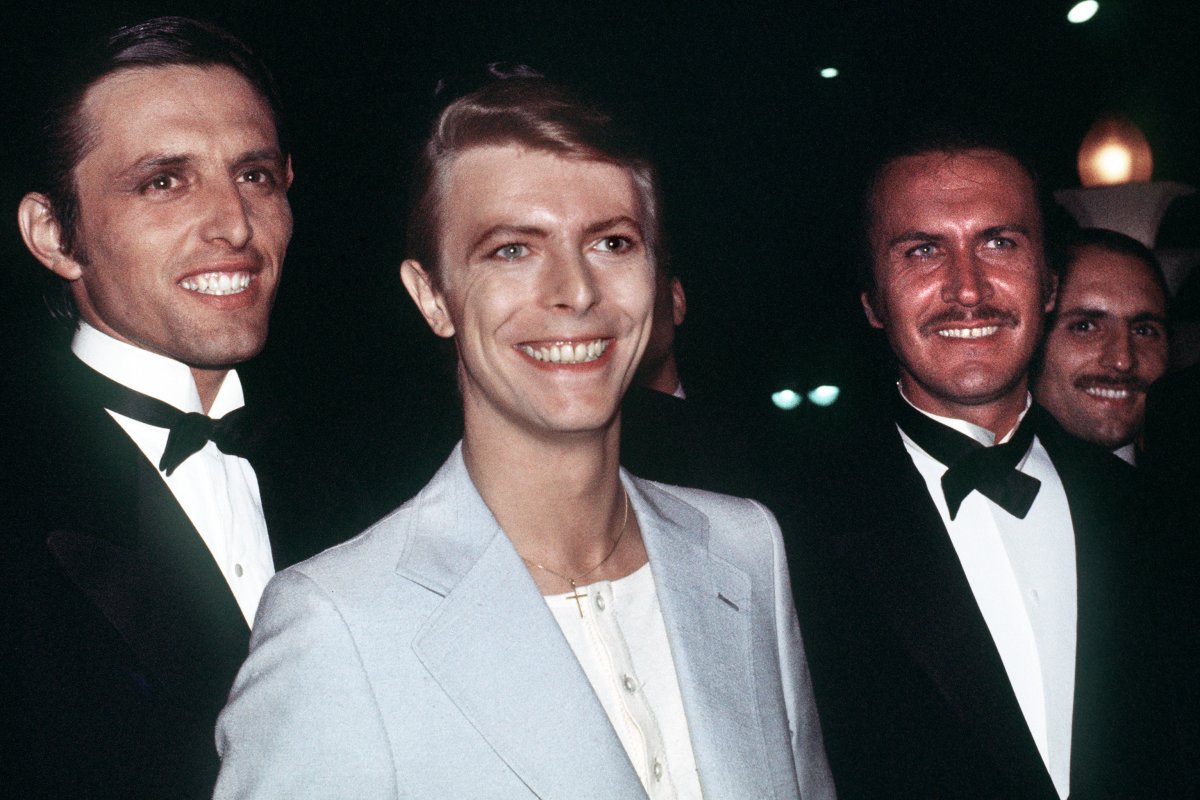On Monday morning, the world was shocked to hear that legendary musician David Bowie, who broke pop and rock boundaries with his creative music, nonconformity, striking visuals and genre-bending persona Ziggy Stardust, had died of cancer at age 69.

The British musician had just released an album, titled Blackstar, on Friday. Bowie, whose hits included Fame, Heroes and Let’s Dance, died “peacefully” and was surrounded by family, representative Steve Martin said. The singer had fought an unspecified cancer for 18 months.

Born David Robert Jones on Jan. 8, 1947 (he died a mere three days after his birthday), Bowie was more than just a musician; he was a record producer, painter and actor, starring in multiple films including Labyrinth and The Man Who Fell to Earth. His career spanned five decades, and he is widely regarded as a hugely influential figure in pop music.
1968 – 1971
After Bowie’s debut album, David Bowie, failed to make an impact on the music scene in 1967, he didn’t release anything else until two years later. In that time, he met dancer Lindsay Kemp and enrolled at the London Dance Centre. It was at the dance school that Bowie learned about image, and he began to think about public personae that he could present to the world. He even became a mime for a brief period of time.

In 1969, Bowie released his second album Man of Words/Man of Music, which contained the as-yet-unknown acoustic folk-rock hit Space Oddity. Not a commercial success upon its release, Bowie’s music label RCA re-released it in 1972 as Space Oddity.
WATCH: David Bowie performs Space Oddity
http://youtu.be/cYMCLz5PQVw
Bowie’s third album, 1970’s The Man Who Sold the World, was a definitive break from his previous work, and it featured dark lyrics and themes. It also ventured into a heavy-rock sound that wasn’t present in his music before. At this point, Bowie started to appear at media interviews and on his tour with his trademark androgynous appearance, stoking curiosity and attracting attention from the press and the public.
In 1971, Bowie released the album Hunky Dory, his final less-than-successful release. After Ziggy Stardust burst onto the scene, Hunky Dory started to take off.

1972
Bowie’s persona, Ziggy Stardust, was introduced to the world on Feb. 10, 1972 at a U.K. concert with the band Spiders From Mars. It was a huge success, and afterwards Bowie catapulted to fame, even creating what one journalist called “the cult of Bowie.” He toured to the United States, and was also a hit there — the likes of his sexual ambiguity and androgyny had only been seen with artists like Little Richard and to an extent Queen’s Freddie Mercury, and he fit into the rising radicalization and sexual awakening of the late ’60s and early ’70s. He released the album The Rise and Fall of Ziggy Stardust and the Spiders From Mars, combining his earlier folk rock and hard rock.
“Offstage I’m a robot,” said Bowie. “On stage, I achieve emotion. It’s probably why I prefer dressing up as Ziggy to being David.”

Bowie invested himself fully into his onstage persona, enough to the point it began to take a physical and mental toll on his health.
Shortly thereafter, Bowie broke up with Spiders From Mars and tried to distance himself from the Ziggy Stardust persona.
“Bowie is a performance artist,” said Professor Ken McLeod of the Faculty of Music and the Department of Arts, Culture and Media at U of T Scarborough in 2013. “It probably gets blurry, even for him, but I don’t know that it’s about him inhabiting that character as much as it is about projection, about performance. I think to a large degree, he’s an actor as much as anything. That’s what makes him interesting, and that’s why he’s innovative. He drew attention to the artificiality of popular music — of celebrity culture, too. It’s conscious artificiality.”

Get breaking National news
MORE: Remembering David Bowie: 5 classic Bowie hits covered
1974 – 1976
In the mid-70s, Bowie moved to New York City and adopted a soulful aspect to his music. He released Diamond Dogs — an attempt to put George Orwell’s dystopian novel 1984 to music — and David Live in 1974. At this time, Bowie developed a cocaine addiction, which gave him an emaciated appearance, emotional problems and paranoia.
In 1975, Bowie released Young Americans, which featured his first number-one hit, Fame. With Beatle John Lennon on back-up vocals (he was famously quoted as describing Bowie’s music as “great, but it’s just rock’n’roll with lipstick on”), the album was an easy commercial success.

A new persona came along with his next album, 1976’s Station to Station, which matched with the album single Thin White Duke. Visually, Bowie embodied his character from the film The Man Who Fell to Earth. By his own admission, Bowie overdosed on cocaine multiple times that year, and his mental and physical health suffered tremendously.

“I was out of my mind, totally crazed,” he said about the time.
1977 – 1979
Perhaps in an attempt to escape what was quickly becoming a dangerous spiral, Bowie moved to Switzerland and purchased a chalet near Lake Geneva. During this time, Bowie decreased his cocaine use and chased pursuits outside of the musical realm, producing more artwork. Eventually he moved to West Berlin and worked with electronic music pioneer Brian Eno and shared an apartment with fellow pop musician Iggy Pop.
WATCH: Fans pay tribute to David Bowie at music icon’s star in Hollywood

Here, Bowie’s music took a turn towards abstract sound, with lyrics becoming more sporadic. His 1977 album, Low was released to much negative criticism (after all, it was ahead of its time — psychedelic rock and disco were dominating the charts), but still managed to perform very well in terms of album sales. His follow-up, Heroes, used instruments like a synthesizer, white noise and other unorthodox instruments, and it was another mainstream hit.
His final album before the ’80s, Lodger, saw his return to drum-and-guitar-based rock pop, and it was around this time that Bowie completely beat his cocaine addiction.
1980 – 1992
David Bowie reemerged in the ’80s as a true tour de force, newly divorced from his first wife, Angela Bowie. In 1981, he paired up with Freddie Mercury to produce the single Under Pressure, which was a smash hit. Arguably his greatest commercial success, Let’s Dance, was released in 1983. The single Let’s Dance, combined with the other two from the album, Modern Love and China Girl, had sexually provocative music videos, so they were guaranteed frequent rotation on a still-developing MTV.
https://www.youtube.com/watch?v=9G4jnaznUoQ
WATCH ABOVE: Mick Jagger and David Bowie’s “Dancing in the Street”
In 1986, Bowie landed the starring role in the Jim Henson movie, Labyrinth. He wrote five songs for the film, which has since become an underground cult hit.
Bowie bid farewell to his solo career in 1989, joining the band Tin Machine. Despite his insistence that the band’s decisions were democratic, Bowie was the heavy influencer when it came to their output and sound. Even fans became disillusioned with Bowie simply being a band member and not a frontman, so he returned to solo work.
From the Global BC archive: We look back at one of the first big events to hit BC Place after it’s opening in 1983: David Bowie’s ‘Serious Moonlight’ tour

He was introduced to supermodel Iman in 1990, and the two hit it off almost immediately. They married in 1992.
“I was naming the children the night we met… it was absolutely immediate,” he said.
1993 – 1998
All those years working with Brian Eno definitely had an effect: in the ’90s, Bowie entered his electronic music period and even started to re-collaborate with Eno. After settling with Iman in New York City, Bowie embarked on the Outside Tour, with controversial tour partner Nine Inch Nails.
Bowie and Nine Inch Nails lead singer Trent Reznor released the single I’m Afraid of Americans to a moderate commercial success. Check it out, below:
Bowie was inducted into the Rock and Roll Hall of Fame in 1996. (Madonna accepted the induction on his behalf.)
1999 – 2012
Bowie and Iman’s daughter, Alexandria Zahra Jones, was born in 2002. During this period of time, Bowie continued to tour in Europe and North America. In June 2004, he suffered chest pain while performing in Germany. Originally thought to be a pinched nerve in his shoulder, the pain was later diagnosed as an acutely blocked coronary artery, requiring an emergency angioplasty.
In the years following the surgery, Bowie decreased his public performances, occasionally appearing at events and contributing vocals in the studio. Bowie felt uneasy about some of his greatest material, once embarking on a “greatest hits” tour saying it would be the last time performing much of his old material. He later relented, however.
“I’m not a natural performer,” he said in the 2002 interview. “I don’t enjoy performing terribly much. Never have. I can do it and, if my mind’s on the situation, do it quite well. But five or six shows in, I’m dying to get off the road and go back into the studio.”
In 2006, Bowie received the Grammy Lifetime Achievement Award.
2012 – 2016
Despite taking a bow from the public scene, Bowie still continued to produce and make music. He released a few albums during this time, including The Next Day and Nothing Has Changed. As mentioned earlier, Blackstar, an album influenced by some of his work in Berlin, was released three days before his death. It is his last official work.
Bowie’s effect on music should never be underestimated, says U of T professor McLeod.
“A lot of it is about the realization that you can be anybody you want to be,” he said in the 2013 interview. “We put people in boxes, but you don’t have to be in a box. You can reinvent yourself. That’s very liberating. You don’t have to be one thing or one persona or one character your entire life. You can do whatever you want.”
BELOW:The music video for Lazarus from the album Blackstar
– With files from The Associated Press

















Comments